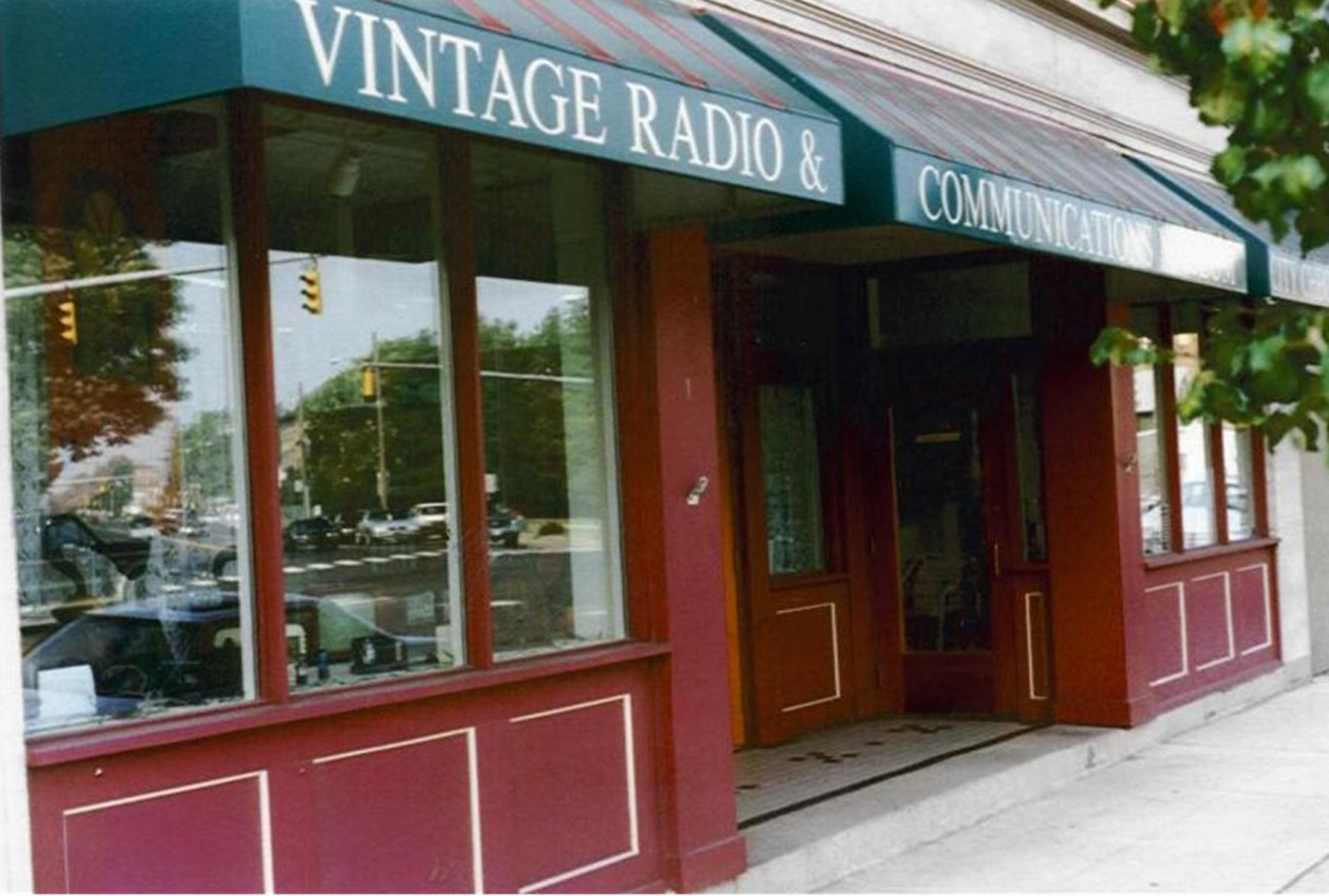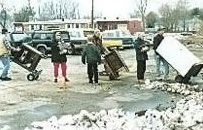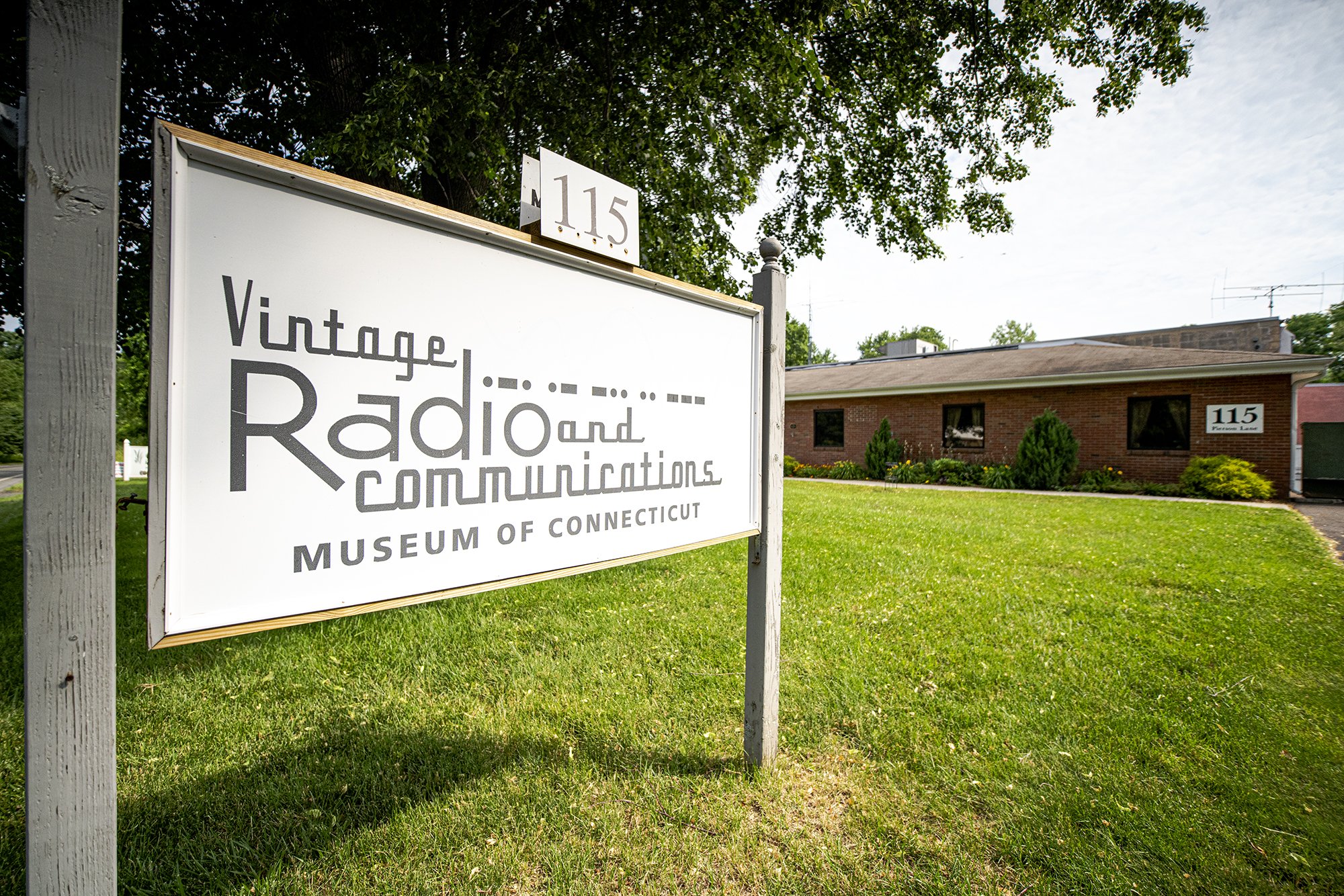
history of our museum
In the Beginning
The Vintage Radio and Communication Museum of Connecticut first opened its doors to the public on Arch Street in New Britain in September 1990. The museum was dedicated to the preservation of old-time communications equipment and to educating the public about this wonderful history. The facility was very small (less than 500 square feet) and was in a fairly rough neighborhood, but it was a start. During the two years of operation at that location, close to 2000 people from all parts of the country toured the displays.
The original museum housed a permanent display called "Five Decades of Radio" which featured a sampling of radios from the 1920's through the 60's. For variety, feature exhibits were rotated every two months and included the history of telephone, television, battery set radios, cathedral radios, brightly colored plastics from the 40's and 50's, movie projection equipment, and more. Many activities developed as a result of the museum including a vintage radio collectors club, basic antique radio repair classes and old radio swap meets, which were attended by people from all over New England.
Looking for Bigger Space
In June of 1992, it was decided that the museum needed more space, but volunteers were hampered by a lack of funding for a larger building. A few new locations were explored but no permanent location was found. After careful consideration by the board of directors, the difficult decision was made to shut the New Britain location down and move the museum's contents into storage in a barn in Avon. Even though time constraints hampered the availability of many of the museum’s guiding members, interest remained high during the next two years. Phone calls asking about the museum or looking for information on old radios streamed in weekly. Some museum volunteers also hosted classes on old radio repair under the auspices of the continuing education program at Manchester Community Technical College
Beginning in May of 1994, work began in earnest on reorganizing and relocating the museum. Letters were sent out to a group of members who had become regulars at the New Britain location. A core of about twelve people began meeting every other Friday night in an effort to find a new home for the museum, raise funds and organize the collection, which had continued to grow since closing the New Britain location. Donations of all kinds came in from a variety of sources, including some strategic finds by die-hard members at tag sales and flea markets. We knew that what we had in the collection constituted a world-class museum display - all we needed was the space.
As the members of the group traveled throughout Central Connecticut, they looked for vacant buildings that would be appropriate for a museum location. When a promising spot was found, the mayor or first-selectman of the town would be contacted and a meeting arranged. Presentations were given to town officials throughout the area, but little interest was shown in the idea until Mayor Robert DeCrescenzo of East Hartford realized the museum would be an asset to his city's downtown revitalization program. After a few meetings, the town offered the museum 1620-square-feet of space in the turn-of-the-century, three-story, multiple storefront building called the Comstock Building.
The Comstock Years
Volunteers began work in November of 1995 to turn the very rough interior space of the Comstock Building into a beautiful environment for the museum. The volunteer effort was greater than anyone could have imagined! The talent, supplies, time and efforts that were donated by members and museum supporters was truly inspirational and indicative of the sweat-equity that the museum would pay to a number of its future locations.
In February of 1996, display pieces were transferred out of storage and into the new museum. On Saturday, February 24, 1996, a grand opening was held and the museum reopened to the public. The facility included displays of radio, TV, motion picture projection equipment and telephones. A small video viewing theater, library and sound effects room rounded out the space. Although the space was less than what the board of directors had hoped for, the museum prospered in this location sponsoring swap meets and special events. The Vintage Radio and Communications Museum became an informative, fun and exciting place that added much to the culture and history of the Central Connecticut area. One of the most memorable events was the appearance of local radio legend Bob Steele, who hosted a morning show on WTIC-AM for over five decades.
During this time the museum also applied for and received its 501(c)3 tax status from the IRS, making us an official non-profit organization.
Another Move
In October of 1997, the Town of East Hartford sold the Comstock Building to private investors. Because of the work that the museum and other building tenants had done on the Comstock Building, the property value soared and it became a viable investment property. Once the sale went through, it became obvious that the museum's time at the Comstock Building was limited
Yet Another Move
The building's buyer owned a real estate firm in West Hartford and stated plans to move the firm to the third floor of the Comstock Building and rehab the second floor for law offices. No mention was made of any changes on the first floor where the museum was located. Our biggest concern was that we had not been able to keep up with our monthly rent to the city, so they had, in a sense, been subsidizing our existence. We were afraid that a private owner would not be willing to do that.
Upon hearing the terms of the sale, our board of directors took a whole new direction on how the museum should be housed. We realized that the future could be much more secure and our financial status more stable, if we owned our own building. However, securing funds for the purchase of a building proved to be very difficult.
Something short of a miracle occurred for the Vintage Radio and Communications Museum in the New Year of 1998. On December 6, 1997, during an indoor swap meet in St. John's Rectory social hall across the street from the museum, we were notified by our new landlord that our rent would double as of January first. We knew that we would need to find a new location quickly.
As fate would have it, the day before we received the notice, the museum had been put in contact with the owner of the old International House of Pancakes building which was located some 1000 feet up the street at 1231 Main Street. The IHOP building's owner told the museum if it ran into any problems in the future in finding facilities that he may be able to help. The very next Monday, we called him back and arranged to rent the IHOP building, which had been vacant for over five years.
We had only three weeks to prepare the new location and move the entire collection! For the next two weekends, approximately 20 volunteers worked at a frenzied pace fixing ceilings, installing light bulbs, paneling walls, patching the roof, cleaning, fixing plumbing, and finally shampooing the rugs, to make the space presentable. On the third Saturday, December 27th, two days after Christmas, and in a light snow storm, 50 volunteers descended on the museum and took a little under three hours to move over 600 pieces up the street to the new location. It was a phenomenal demonstration of community spirit and volunteerism.
Putting the display in some sort of order took weeks. But against all odds, the museum stayed open and continued to serve the public. Two days after the move, in the middle of the week, some of the volunteers were working on the display when two groups of people walked in, one from Nashville, Tennessee and the other from Ohio. The Vintage Radio and Communications Museum of Connecticut was alive and well.
The old Town Hall Hardware Building was located at 711 Main Street and was about a mile down the road from the IHOP location. The building was much bigger than any of our previous homes at approximately 7000-square-feet. Its size allowed the museum to set up further displays, using donated pieces that had been in storage. A library area was created, as well as a radio repair facility. Museum members repaired the building's roof and facade, insulated the brick walls, installed new lighting fixtures and repaired the cracked floor.
Volunteers also restarted hosting radio repair classes through Manchester Community College and became active in East Hartford's Main Street Plus revitalization group. But things were not to stay settled for too long.
In late 2000, the museum was told that the 711 Main Street location would soon be torn down by the State of Connecticut to make way for a wider I-84. The museum searched in vain for a new location in East Hartford, but the museum had grown so large that no site that was easily affordable could be found. That's when the town of Windsor, just over the Connecticut River, started to express interest.
33 Mechanic Street
In downtown Windsor, an 85,000-square-foot factory building had been on the market for some time and the town was looking for a catalyst to spark revitalization in Windsor's historic downtown area. After a failed attempt to form a partnership with a developer, the museum made an offer on the building and the owner, Mr. John Moynahan, graciously agreed to not only sell the building for an extremely low rate to the museum, but self-mortgaged the property for five years. In November 2001, the museum officially became owners of 33 Mechanic Street in Windsor.
The museum worked with the Town of Windsor to negotiate a deal with a real estate developer to convert the building into a new home for the museum and housing. However the negotiations proved difficult with all of the developers saying the museum would have to leave the building in order for housing to be built. After almost two years of looking, the museum reached a deal with the Corporation for Independent Living, which purchased the building from the museum for a price that allowed the museum to concentrate on its next, and hopefully final, move.
115 Pierson Lane
During the negotiations for the sale of the Mechanic Street location, the museum worked with the Town of Windsor to find another, more manageable location for the museum. This new location was about one mile from Mechanic Street, a 20,000 square foot building that offered the museum one level for easy display setup.
The arduous move of the collection took place from September to November 2005, with volunteers helping with trucks and an 18-wheeler donated by Woodland Moving and Storage of Hartford, CT. The museum finalized the purchase 115 Pierson Lane for $600,000 in February of 2006 and throughout 2006 and 2007, volunteers and contractors paid by a state grant, helped turn the bare insides of the building into a space fitting for the museum's expanding collections. The museum during this time also adopted new bylaws and formulated a new board of directors, allowing volunteers to concentrate on getting the museum up and running rather than spending time on administrative issues.
A New Direction
From its inception, the museum, like most radio museums, was a collector's museum. Radios were grouped together, usually by style: all the consoles, all the cathedrals, the tombstones, etc. Radios, telephones, televisions, etc. had their own floor space independent of other display categories. Now, faced with the financial obligations imposed by having to maintain its own facility, the board recognized it needed to attract a wider audience than just collectors
The board came up with the concept of showing the evolution of electric communications, starting with the telegraph, through sound recording, the telephone, wireless radio, and so on. The time line was divided into decades, from the mid 1800s through the 1970s. A mission statement was drafted: "To show how communications has changed our lives." Besides talking about the articles themselves, docents expanded their explanation to show how one development led to another, how the invention impacted our society, and so on.
A gala was held in 2007 to celebrate the official opening of the museum to the public. Town officials, radio history aficionados and others embraced the new museum with enthusiasm. Windsor did indeed have a genuine tourist attraction.
The museum's volunteers who were amateur radio operators had formed a club at the Mechanic St. location but had no space at that facility for a ham station. Now at Pierson Lane, they built a working station, obtained license W1VCM (for Vintage Communications Museum), and erected a beam antenna alongside the building, thanks to a grant from the American Radio Relay League. The station is on the air most weekends, giving the museum a presence on the air as the hams talk with stations around the world.
Outreach
Starting 2008 the museum reached beyond its walls as volunteers took part in Open Cockpit events at the New England Air Museum with displays of vintage communications gear that have been extremely popular. And other volunteers continue to conduct adult education courses at local community colleges covering the repair of old radios.
Reducing Our Environmental Impact
In 2008, Ed Sax, retired engineer, museum volunteer, and visionary, developed an energy-saving concept adaptable to a wall as well as a sloped roof. He obtained a grant to build his "solar adaptive wall" along the exterior wall of the museum. The passive solar installation uses the sun's energy to help cool the building in the summer and warm it in the winter. Completed in 2010, the wall has made a measurable impact on the museum's utility bills and has attracted the attention of ecologically-minded parties from around the region who have been impressed with Ed's project.
The Future
When the Pierson Lane building was acquired, a decision was made to build out only the front half in order to open as quickly as possible, leaving the back area for storage and future expansion. Plans for this area include space for more displays such as computers and other forms of digital communications, a lecture room, offices, a radio repair facility, a room for the museum's collection of saleable vacuum tubes and a record library.
The Vintage Radio and Communications Museum of Connecticut celebrated its 25th anniversary in September, 2015. Fueled by volunteers who keep it alive through their love and dedication, it continues to grow and evolve; its future history yet to be written.













